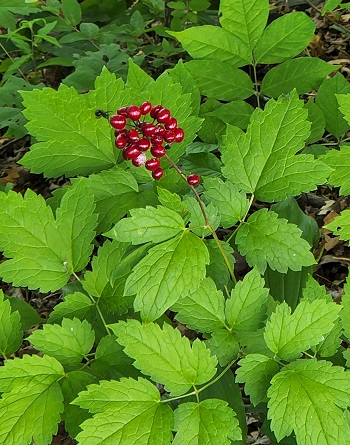Red baneberry (Actaea rubra), a highly toxic plant, can be found throughout North America, Europe, and Asia. Despite its toxic properties, it is a popular ornamental plant due to its striking red berries and delicate white flowers. With that said, this is a plant that should be avoided if you have children or pets.
General Comments:
Red baneberry is a highly poisonous plant that can be fatal to humans and animals. It contains a toxin called protoanemonin, which can cause a wide range of symptoms when ingested, including vomiting, diarrhea, dizziness, seizures, and in severe cases, cardiac arrest. It is important to exercise caution when handling or consuming any part of this plant.
Common Names:
Red baneberry is also known by a variety of other common names, including red cohosh, doll’s eyes, snakeberry, and White Baneberry
Description:
Red baneberry is a perennial herbaceous plant that can grow up to 1 foot – 3 feet tall. It has delicate white flowers that bloom in late spring or early summer, which are followed by clusters of bright red berries. As the picture shows, leaves are alternate, 2 to 3 times compound, sharply toothed and lobed. The berries are about 1/8 inch in diameter and have a distinctive black “pupil” on each one, which gives them the appearance of doll’s eyes.

Territory:
Red baneberry is native to North America, Europe, and Asia. In North America, it can be found from Alaska to Newfoundland in the north, and from California to Georgia in the south. It is also found in parts of Europe and Asia, including Russia, China, and Japan.
Habitat:
The plant typically grows in moist, shady areas such as forests, meadows, and along stream banks. It prefers rich, loamy soil and is often found growing alongside other shade-loving plants such as ferns, wildflowers, and mosses.
Poison:
All parts of the plant are toxic, but the berries are the most poisonous. The leaves, stems, and roots also contain the toxin protoanemonin, but in smaller amounts.
Symptoms of Poison:
Ingesting any part of the red baneberry plant can cause a wide range of symptoms, including vomiting, diarrhea, dizziness, seizures, and in severe cases, cardiac arrest. Symptoms typically appear within 30 minutes to 2 hours of ingestion and can last for several hours. If you suspect that you or someone else has ingested red baneberry, seek medical attention immediately.
Conservation Status:
Red baneberry is not currently listed as endangered, but it is considered a species of concern in some parts of its range. Habitat loss and fragmentation are the primary threats to this plant, as it requires specific environmental conditions to thrive. Additionally, overharvesting of the plant for its ornamental value has contributed to its decline in some areas.
Notes of Interest:
Despite its toxicity, red baneberry has been used in traditional medicine to treat a variety of ailments, including rheumatism, fever, and snake bites. However, these uses are not supported by scientific evidence and should be avoided due to the plant’s poisonous properties.
Red baneberry is a highly toxic plant that should be handled with caution. Despite its toxic properties, it remains a popular ornamental plant due to its striking red berries and delicate white flowers. If you encounter this plant in the wild, admire it from a safe distance and do not attempt to handle or consume any part of it.
Sources:
• USDA Plants Database: Actaea rubra. (n.d.). Retrieved March 31, 2023, from https://plants.usda.gov/home/pl